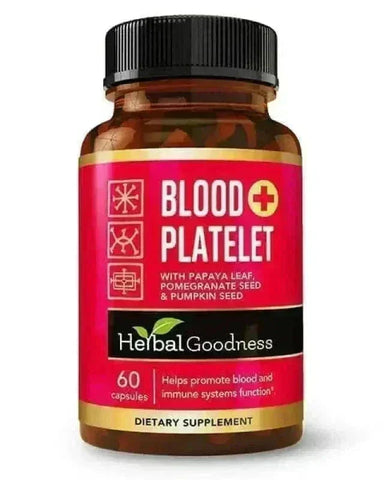Understanding Blood Platelets and How to Support Them Naturally
Blood platelets are one of the most important yet often overlooked components of our blood. They’re small but mighty, playing a vital role in maintaining balance within our circulatory system. This guide explores what platelets do, what platelet count means, how mean platelet volume is measured, and lifestyle tips for supporting platelet health.
What Are Blood Platelets?
Blood platelets, also known as thrombocytes, are small cell fragments that circulate in the bloodstream. They’re produced in the bone marrow and act as the body’s natural first responders whenever blood vessels are injured. Their key function is to maintain normal blood flow by forming a temporary barrier at the site of a wound.
While red blood cells carry oxygen and white blood cells support the immune system, platelets work closely with both to maintain overall balance within the blood.
Understanding Platelet Count
Your platelet count measures how many platelets are in a specific amount of blood. It provides valuable information about the general state of your blood system.
-
A low platelet count indicates there are fewer platelets circulating in the blood.
-
A high platelet count means there are more than usual.
Several factors such as nutrition, hydration, and overall wellness can influence platelet numbers. Regular testing helps monitor trends over time.
What Is Mean Platelet Volume (MPV)?
Mean Platelet Volume (MPV) refers to the average size of platelets in the blood. It’s an indicator of how active the platelets are and provides additional insight beyond the basic platelet count.
A balanced MPV level often suggests that the body is maintaining a stable production and renewal process. Tracking both platelet count and MPV together provides a more complete picture of how platelets are functioning.
Platelet-Rich Plasma (PRP): A Simple Explanation
You may have heard of platelet-rich plasma (PRP) in wellness or fitness discussions. PRP refers to blood plasma that contains a higher concentration of platelets. It’s typically discussed in the context of body recovery and regenerative processes.
While PRP is a specialized procedure, it demonstrates the importance of platelets and their diverse functions in the human body.
Supporting Platelet Wellness Naturally
Although platelet numbers are influenced by many internal factors, nutrition and lifestyle can play supportive roles. Here are general ways to maintain healthy blood composition:
1. Eat a Variety of Nutrient-Dense Foods
A balanced diet rich in vegetables, fruits, legumes, and lean proteins provides the vitamins and minerals that support normal blood formation.
2. Stay Hydrated
Water supports circulation and helps maintain fluid balance in the bloodstream.
3. Get Enough Rest
Adequate rest allows the body to carry out repair and renewal processes, supporting healthy cell turnover.
4. Moderate Alcohol Intake
Excessive alcohol consumption can impact overall wellness and blood balance. Moderation supports healthy body function.
5. Prioritize Whole Foods
Choose natural, minimally processed foods whenever possible to nourish the body with the nutrients it needs to function optimally.
Foods That May Help Support Platelet Function
Certain foods are particularly rich in vitamins and minerals that contribute to healthy blood composition:
-
Leafy Greens (like spinach and kale) – contain essential nutrients that support normal blood function.
-
Citrus Fruits (like oranges, kiwi, and papaya) – provide vitamin C, which supports iron absorption.
-
Legumes and Lentils – offer plant-based iron and folate.
-
Whole Grains – supply B-vitamins important for cell production.
-
Beets and Carrots – contain natural compounds that promote circulation.
These foods can be included as part of a well-rounded diet to encourage optimal blood health.
Platelet Count and Lifestyle Balance
A balanced lifestyle supports overall wellness, including healthy platelet production. Factors such as stress management, physical activity, and hydration influence how the body regulates blood components.
Incorporating regular exercise, staying hydrated, and practicing relaxation techniques (like deep breathing or yoga) are simple yet effective ways to maintain a healthy circulatory system.
FAQs
Q1. What exactly are blood platelets?
Blood platelets are small, disc-shaped cell fragments in the blood that help maintain proper blood flow and vessel integrity.
Q2. What is considered a normal platelet count?
A typical platelet count falls within a specific range established by laboratory standards. Regular checkups can help monitor your count over time.
Q3. What does “mean platelet volume” (MPV) mean?
MPV measures the average size of platelets and helps provide additional context alongside platelet count.
Q4. Can food help maintain normal platelet levels?
Yes, a diet rich in vitamins, minerals, and antioxidants can support general blood wellness, which includes platelet function.
Q5. What’s the difference between blood plasma and platelets?
Blood plasma is the fluid portion of the blood that carries platelets, red and white blood cells, nutrients, and waste products. Platelets are solid components within that fluid, playing a key role in balance and repair.
Support Your Blood Wellness with Platelet Plus
If you’re interested in supporting your blood wellness and maintaining a balanced lifestyle, explore our Platelet Plus – Capsule 60/600 mg, thoughtfully created with plant-based ingredients and essential nutrients.
Experience the Herbal Goodness commitment to quality, purity, and balance, because nature provides everything we need for everyday wellness.
Shop Platelet Plus today and nourish your body naturally.
Related:
References:
-
Cleveland Clinic: What Are Platelets?
-
National Center for Biotechnology Information (NCBI): Platelet Function Overview
-
Medical News Today: Foods That Support Platelet Function













